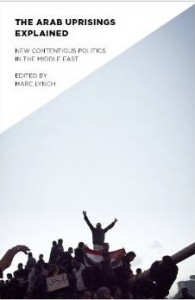 The Arab Uprisings Explained: New Contentious Politics in the Middle East, edited by Marc Lynch.
The Arab Uprisings Explained: New Contentious Politics in the Middle East, edited by Marc Lynch.
This new book from Columbia University Press brings together many of the top Middle East political scientists to explain the eruption, significance, and fortunes of the Arab uprisings of early 2011. The chapters systematically and rigorously explore similarities and differences in the uprisings across the countries of the Middle East, and consider the uprisings from a broad theoretical and comparative perspective. Available and ideal for fall 2014 courses!
Contributors:
1 Introduction — Marc Lynch
2 Theories of Transition — Daniel Brumberg
3 Diffusion and Demonstration — David Patel, Valerie Bunce and Sharon Wolchik
4 Authoritarian Learning and Counterrevolution — Steven Heydemann and Reinoud Leenders
5 Media, Old and New — Marc Lynch
6 Inter-Arab Relations and the Regional System — Curtis Ryan
7 States and Bankers — Clement M Henry
8 Militaries — Robert Springborg
9 Political Geography — Jillian Schwedler and Ryan King
10 Labor Movements and Organizations — Vickie Langohr
11 Islamist Movements — Quinn Mecham
12 Elections — Ellen Lust
13 Political System Preferences — Mark Tessler and Michael Robbins
14 Political Attitudes of Youth Cohorts — Michael Hoffmann and Amaney Jamal
15 Constitutional Revolutions and the Public Sphere — Nathan Brown
That lineup of authors not enough for you? Here’s some blurbs:
This important volume addresses a series of core questions about the origins, dynamics and consequences of the Arab uprisings in a rigorous way that transcends headlines and quick, opinion-based analyses.
(Melani Cammett, Author of Globalization and Business Politics in North Africa: A Comparative Perspective)
The is an outstanding volume on the Arab uprisings — one of the very best so far. The articles by leading scholars are thematic, covering key factors and actors at play as the uprisings continue to unfold. It is a well-informed, theoretically grounded collection that advances our understanding of the dramatic upheavals in the Middle East. I highly recommend it.
(Shibley Telhami, Anwar Sadat Professor for Peace and Development, University of Maryland and author of The World Through Arab Eyes: Arab Public Opinion and the Reshaping of the Middle East.)
This extremely useful and timely volume directs the reader away from individual country stories, which have dominated our accounts of the Arab uprisings of 2011, toward thematic and topical arguments that can provide the basis for a broader understanding of these events. Expected topics like diffusion, media, the military and elections are joined by analyses of less examined themes like labor, political space and banking systems. The treatments are sophisticated, but accessible to students and general readers as well. In all, an excellent contribution to what is the most important question facing scholars of Middle East politics
(F. Gregory Gause, III, Bush School of Government, Texas A&M University)
Published reviews of The Arab Uprisings Explained: New Contentious Politics in the Middle East (2014).
Sean Yom, “The Arab Spring: One Region, Several Puzzles, and Many Explanations.” Government and Opposition 50, no.4 (2015): 682-704. Link here.
“Like any early theorizing, however, a closer look at specific cases raises some questions. Here, Lynch’s The Arab Uprisings Explained shines… They represent the first wave of rigorous theorizing, and it comes just a few years after an historical rupture shook the field of Middle East politics. ”
Jane Kinninmont, “Unrest in the Arab world: Why the Arab Spring still matters.” International Affairs 91, no.5 (2015): 1141-9. Link here.
“The Arab uprisings explained,takes a thematic approach, offering a comparative overview of key structural issues such as the role of the military and the independence of the private sector. Of the three books, this provides the most useful basis for understanding the differences in post-uprising trajectories and the factors that have limited opportunities for
democratic change.”
Andre Bank, International Journal of Middle East Studies
“In sum, The Arab Uprisings Explained is one of the best contributions on the contemporary politics in the Arab Middle East, especially for the early period of mass mobilization and regime responses in 2011–13. It stands out in two important ways: first, it highlights new political dynamics such as cross-national protest diffusion or authoritarian regime learning that have been crucial in explaining the different political trajectories across the region and that have not been so thoroughly addressed; second, more than almost all extant studies of the Arab Uprisings, this volume explicitly tries to connect with disciplinary debates in mainstream political science.”